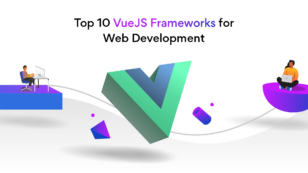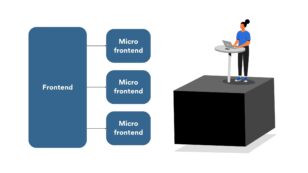Top 21 Vue JS Interview Questions and Answers for 2023
What is Vue JS? What is Vue JS used for? What are some of the main features of Vue JS? Which is best: Angular, React, or Vue? What are the popular Vue JS interview questions?
What is Vue JS?
Vue JS is an open-source, progressive JavaScript framework that creates dynamic web interfaces. Vue JS is one of the well-known frameworks for streamlining web development services. Vue JS focuses on the view layer, and it can be seamlessly integrated into large front-end development projects.
Vue JS installation is simple. In Vue JS, interactive web interfaces are simple to comprehend and quick to construct for any developer.
Vue JS’s initial version came out in February 2014. The framework currently has over 197k stars and over 32k forks on GitHub, making it highly rated and liked by developers.
What are some of the main features of Vue JS?
Here are some of the main features of Vue JS:
-
Virtual DOM
Vue JS uses virtual DOM extensively. Instead of altering the original DOM, Vue JS uses a duplicate DOM placed in the form of a JavaScript data structure.
Every time there is a change in the program, the JavaScript data structure gets modified and compared to the original data structure. This feature offers quick hassle-free modifications in the app. -
Data Binding
With the help of a binding directive called v-bind that is included with Vue JS, data binding assists in manipulating or assigning values to HTML attributes, changing the style, and assigning classes. -
Components
Components are one of the important features of Vue JS that helps create custom elements, which can be reused in HTML. -
Event Handling
V-on is the attribute added to the DOM elements to listen to the events in Vue JS. -
Animation/Transition
When HTML elements are added, changed, or removed from the DOM, Vue JS offers various techniques to apply the transition. The built-in transition component in Vue JS needs to be wrapped around the element to produce the desired transition effect. Developers can easily make the interface more interactive by adding third-party animation libraries. -
Directives
Vue JS has built-in directives such as v-if, v-else, v-show, v-on, v-bind, and v-model, which perform various actions in the front-end development. -
Routing
Navigation between pages is easy with the help of Vue-router. -
Lightweight
Vue JS script is lightweight and its performance is also very fast. -
Vue-CLI
Vue JS can be installed at the command line using the Vue-CLI command-line interface. Vue JS helps to build and compile the project easily using Vue-CLI.
Related post: Here’s What You Should Know About Vue.JS
Basic-level Vue JS interview questions and answers
- What do we refer to as a Vue app that is rendered server-side?
A server-rendered Vue JS app might be described as ‘universal’ or ‘isomorphic’. These terms indicate that the bulk of application programs are executable on both the client and the server side.
- Does Vue support TypeScript?
Yes. Vue JS ships TypeScript formal type declarations. This function holds true for Vuex, Vue-router, and Vue core. - What is a component system in Vue JS?
The component system allows the abstraction of complex programs into smaller, reusable, self-contained units. - What are props in Vue JS?
Props are a type of component where special attributes can be registered. - How to create the two-way binding on textarea, form input, and select elements?
Using V-model, developers can create the two-way binding on textarea, form input, and select elements. This model automatically selects the appropriate technique to update components depending on the type of input. - Which event modifiers are available in Vue JS?
The list of available event modifiers is as follows:- stop
- prevent
- capture
- self
- once
- passive
- What is matching by dynamic route?
A dynamic segment in a route is identified by the colon ‘:’ and is used for matching by the dynamic route. This function enables the route to accept the dynamic value. This feature is useful for transmitting a particular ID along the route.
Intermediate-level Vue JS interview questions and answers
- Explain the difference between slots and scoped slots.
A slot in a child component is a blank space that is filled with data passed from the parent component. Accessing the properties of child components is a restriction of using conventional slots. The child component receives a standard slot that was built within its parent’s scope.
On the other hand, a scoped slot enables developers to use the data in the slot content and send data from the child component to the parent scope. - Explain the difference between v-if and v-show.
To conditionally render a component, developers use the v-if and v-show directives. However, each directive behaves differently, making them perfect for different use scenarios.
Although v-if reduces the initial render time, v-if is not the best solution to frequently show and hide items.
V-show renders the element on the DOM and utilizes CSS to show or hide the element depending on the expression’s outcome. As all the items are added to the DOM, unlike v-if, v-show has no impact on the initial render cost. However, compared to v-if, the cost of displaying and hiding an element is lower because elements aren’t added or removed. - What are functional components?
Functional components are alternate types of components that render without establishing a component instance. These components lack state and don’t follow the typical component lifecycle.
Instead of using an options object, developers design a functional component using a simple function. This process serves as the component’s render function. - Describe Single File Components or SFCs.
Single File Components are similar to other components. They are self-contained in their own files. Here are some of the benefits of SFCs:
- Global definitions: All SFCs are registered globally and given unique names.
- Robust templates: Instead of using a single template property like other components, developers can easily create template code in SFCs.
- CSS support: SFCs allow developers to apply CSS to the component itself.
- Support for preprocessors: SFCs support preprocessors like babel, SAAS, and others.
- What is the composition API in Vue JS?
The composition API has many advantages including improved logic reuse, improved type inference, and more adaptable code organization.
Composition API is a set of APIs that allow developers to create Vue components using imported functions instead of declaring options. Composition API includes:
- Reactivity API (ref() and reactive()) – directly create reactive states, computed states, and watchers.
- Dependency Injection (provide() and inject()) – leverage Vue’s dependency injection system while using reactivity APIs.
- Lifecycle Hooks (onMounted() and onUnmounted()) – hook into the component lifecycle.
- What are mixins in Vue JS?
A mixin object can contain any component option. A component that uses a mixin has all of the mixin’s options ‘blended’ into its own options. - How do you verify if a mutation occurs in Vue JS?
Mutations are functions that depend only on their arguments. Testing them is simple. Mutations can be contained in the store. In addition to the default export, the mutations should also be exported as a named export.
Related post: Vue vs React: Which Framework to Choose and When
Advanced-level Vue JS interview questions and answers
- Why should arrow functions not be utilized in Vue instances when writing lifecycle hooks?
Arrow functions cannot declare ‘this’ because they are not self-contained. The parent function’s context is the only context in which the arrow functions can be used.
When the arrow function (=>) is used in the Vue app, issues arise since the term “this” does not bind to the Vue instance.
As a result, developers strongly advise utilizing the ordinary function rather than the arrow function. - Mention ways to add animations in a Vue application?
Vue provides four ways to add animations to an application:
- Transition and TransitionGroup – Vue components for handling enter/leave and list transitions.
- Class-based animations – animations that trigger the CSS class addition.
- State-driven animations – transition effects applied by interpolating values such as a component’s style binding.
- Watchers – watchers to animate an element based on a numerical state.
- What are plugins in Vue JS?
Plugins are beneficial for code reuse, similar to composition API. Adding functionality at the app level is made easier via plugins. This Vue JS interview question could be used to gauge a candidate’s knowledge of Vue’s more sophisticated features and how they relate to more effectively optimizing your code base.
Self-contained code called plugins are frequently used to provide functionality at the app level. Either an object or a function can be used to define a plugin. Both strategies call for the exposure of an install() function, wherein the app.use() function and various extra properties may be given. - What is Vue-loader?
Developers can create single-file components in the Vue format using the webpack loader plugin: Vue-loader.
A single component file has three sections: template, script, and style. The Vue-loader module allows webpack to extract and process each section using different loader modules, such as the SASS or SCSS loaders.
Developers can quickly create apps using .vue files thanks to the configuration.
With the Vue-loader module, static assets can also be viewed as module dependencies, and webpack loaders can be used to process them. When developing, Vue-loader also makes hot reloading possible. - Describe the best way to maintain state in a Vue application.
When an application grows in size, both in terms of features and codebase, managing state becomes difficult, and it is not advisable to use an endless network of downstream props and upstream events. In such a case, it becomes essential to hand over state control to a centralized management system.
The recommended paradigm for saving states centrally in the Vue ecosystem is Vuex, which is the official state management library.
The preservation of a central state is possible using Vuex. Components use Vuex as a reactive data store that updates in response to state changes. Multiple independent components can use the same core state store. - How can you improve the Vue JS app’s performance?
A Vue application may respond slowly for the following reasons:
- You’re relying on many third-party libraries that are misused or too large.
- You have many unoptimized and non-compressed photos.
- You are not using lazy loading to load your images.
- You are not reusing functionalities across your program.
- You have many pages and want to load them all at once.
Fixing these issues will improve the Vue JS app’s performance.
- What are some of Vue JS’s most crucial directives?
Here are a few of Vue JS’s most crucial directives:
- V-if inserts or removes DOM elements based on specified phrases.
- Only when the expression adjacent to v-if resolves to false, v-else displays content.
- V-show is similar to v-if. However, instead of rendering all elements to the DOM, V-show uses the CSS display property to show and hide them.
- Developers can use v-for to iterate over items in an array or object.
- The v-model is useful for two-way data bindings.
To sum up
These Vue interview questions and answers will help you prepare for a junior and senior-level Vue developer positions.
However, remember that there is more than just one correct response to open-ended Vue interview questions. Most times, interviewers are interested in understanding the rationale behind your responses. So, always be ready for questions about how you arrived at your solutions.
Kindly note that technical expertise is only one part of the hiring process. Most recruiters give equal weightage to work experience and soft skills along with technical expertise.
If you are an experienced and skilled Vue JS developer looking for a high-paying remote job, visit Turing.com. Turing’s developers earn better than the market average in most countries, working with top US companies.
FAQs
- What is Vue JS used for?
Web interfaces and single-page apps are the main uses of Vue JS. However, the HTML extensions and JS base operate in conjunction with an Electron framework. This feature makes Vue JS useful for developing desktop and mobile apps, making it a highly favored front-end tool. - Is Vue a framework or library?
Vue JS is a JavaScript framework for creating single-page apps and user interfaces. - Which is best Angular, React or Vue?
Angular is a complete front-end framework, React is a UI library, and Vue is a progressive JavaScript framework. Although they can be used to create front-end apps practically interchangeably, they aren’t exactly the same. Therefore it makes no sense to compare them and comprehend their variations.
Join a network of the world's best developers and get long-term remote software jobs with better compensation and career growth.











